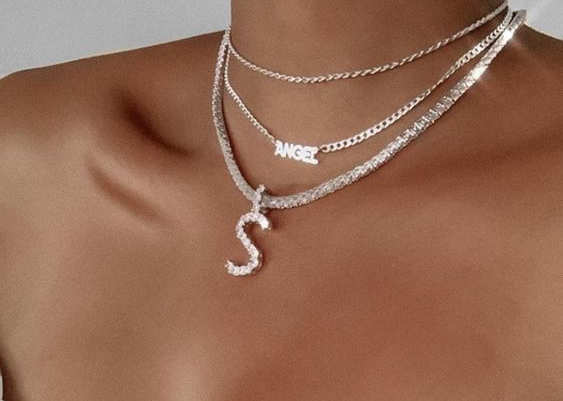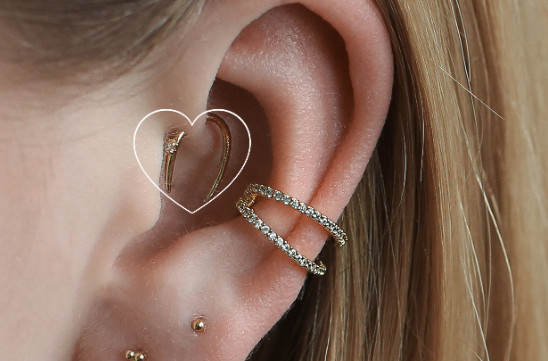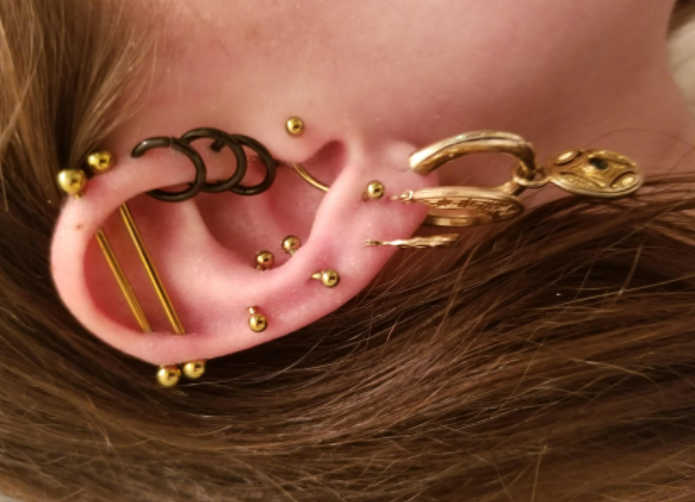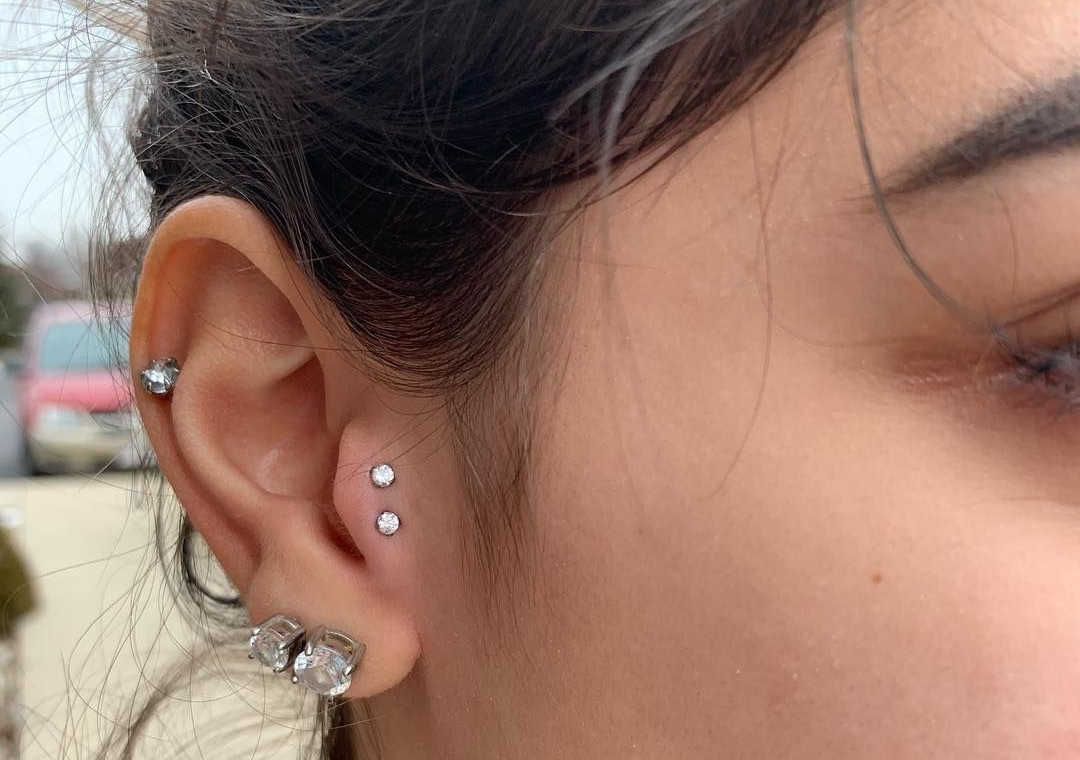5 Ways to Test Silver Jewelry at Home
- Ice Test
- Bleach Test
- Rare Earth Magnet Test
- Acid Test
- Scratch Test
The Ice Test for Silver
I’m listing this test first not because it’s the most accurate— it isn’t completely reliable for a variety of reasons—but because it’s one of the easiest tests to conduct.
While the ice test is much easier to perform on silver pieces with a good amount of surface area (like spoons, coins, and bars), you can also use it with small silver jewelry using a special technique.
You see, silver is an excellent heat conductor, since its a transition metal. Silver is actually one of the very best heat conductors, with copper coming right behind it on that scale, meaning this test also works with sterling silver. This means that ice, when placed in contact with a silver piece, will melt faster than when in contact with pretty much anything else at room temperature.
If you’re testing something with a good amount of surface area, do the following:
- First, you’ll need some ice. Any ice cube will do, but small ones are preferable;
- Preferably, you’ll also want to have another object that is identical or similar to the one you’re testing, made of a material that is not silver (steel, iron, nickel, etc), so you can test them both and compare the results;
- Make sure the objects you’re testing are at room temperature. Place the ice on top of the objects. Now watch the ice closely: the ice in contact with the silver piece should melt faster than the one in contact with the piece made out of other metal. The ice on the silver piece should melt completely before the ice on the object does so. If they melt at the same rate, you likely have a fake on your hands!
For small pieces with almost no surface area, like rings and other such things, you can also perform this test using the following technique:
- Hold your silver piece with two fingers in one hand, and another non-silver metal piece in the other hand, also with two fingers. Make sure your hands are both at the same temperature, as well as the pieces you’re testing.
- Get a large piece of ice, like a bar or slab of ice. You can also do this with two ice cubes, but it’s way easier with a larger piece of ice.
- Now you’ll want to gently press both pieces into the ice, making sure they’re well spaced out from one another, and that each piece has about the same amount of surface area of both pieces are touching the ice;
- Since silver conducts heat so well, it should start to melt the ice faster than the other object by conducting the heat of your fingers into the ice more efficiently. After a while this should make a hole in the ice in the shape of the object. If the hole made by the silver object is deeper, then it’s likely not a fake.

The Bleach Test for Silver
An easy way to test pretty much any silver jewelry is by simply using your domestic grade bleach. Bleach is a powerful oxidation agent, and since silver is susceptible to oxidation, it should tarnish pretty quick in contact with bleach. Other, more common metals tend to tarnish differently and at a much slower rate due to their more stable molecular structure.
This test also works with both pure silver and sterling silver.
Since this test involves bleach, be careful while conducting it.
- Put your silver piece or jewelry in a place that you can easily wash later to clean up any bleach residue, such as a plastic container, a sink, or a tub. If you’re doing this test in a sink, close or screen the drain hole so you don’t risk accidentally knocking your jewelry down the drain.
- Place a single drop of bleach on the piece. Make sure the drop only touches the silver part of your jewelry, and not any gemstones or other metals it may be attached to.
- Watch closely as the metal tarnishes. The area in which the bleach drop is placed on should start to become darker and darker really quickly, until it loses all its characteristic shine and original color, becoming a dull shade of grey instead.
If your piece takes more than a few seconds to tarnish, then it’s likely a fake piece! However, keep in mind that pieces that are only covered with a coating of silver will tarnish during this test just as if they were solid silver. Thus this test can’t help you distinguish a piece composed entirely of silver or sterling silver from one that is just covered with it.
Rare Earth Magnet Test
This test can be easily done at home as long as you have a powerful rare earth magnet, like one made out of neodymium. You can easily and cheaply buy neodymium magnets online.
Silver is a paramagnetic metal, meaning it only exhibits very weak magnetic proprieties, and should not attach to any consumer-grade magnet.
Keep in mind, however, that other metals that look like silver do not exhibit any strong magnetic interactions either, so this test should be used in conjunction with other tests.
- Put your silver piece on top of a non-magnetic surface, such as a wooden table, with no other metallic objects nearby.
- Now put your magnet close to the piece and see if it can attract it. Try touching the magnet on the piece and try lifting the magnet. If the piece remains attached with enough force to dangle from the raised magnet, then it’s very unlikely it is made of silver.
Testing Jewellery With Acid
Now here is where things get a little technical. You can perform these tests at home, but you’ll need a special silver acid test kit. These can be easily bought through Amazon or Ebay.
Follow the instructions provided with the kit carefully. It goes like this:
- Take the small black stone tile provided with the kit and put it on a flat surface for better usage. If you don’t have a smooth black stone, you can use a piece of unglazed ceramic tile instead.
- Get your silver or sterling silver piece and carefully rub an inconspicuous part of it back and forth on the black stone or unglazed ceramic tile. Don’t rub it too hard! Just enough to cause silver lines to appear on the stone. Make enough lines to cover a small area, as depicted in the video above.
- Get the testing acid and pour a bit of it on the stone over the marks you made, enough to completely cover the marks. Use just enough acid to cover the marks.
- Now get a paper towel or napkin and use it to wipe the acid off the stone using it, also wiping off the marks you made on the stone using the silver piece.
- Look at the smear of acid in the paper towel or napkin you just used and watch it carefully. It should acquire a certain color in a few seconds.
Depending on the color you get, it will mean your piece is made of different materials. Use the following color code to identify the material:
- Bright Red: Fine Silver
- Darker Red: 925 Silver (sterling silver should look like this)
- Brown : 800 Silver (80% silver)
- Green : 500 Silver (half silver content)
- Yellow: Lead or Tin
- Dark brown: Brass
- Blue: Nickel
Scratch Test for Silver Jewelry
- First, you’ll need a jeweler’s file. You can find kits of these on Ebay and Amazon;
- Get your silver piece and find a very inconspicuous place on it, a place people will never be able to look at when you’re wearing it. For example, the inner part of a ring.
- Take your jeweler’s file and, using its point, make a scratch on the silver, moving the file a few times.
- Look at the metal in the scratch; is it a different color?
- You can also pour a little bit of your testing acid right on the scratch and wipe it off with a paper towel as in the test above.
If the color of the metal beneath isn’t silvery, or if the acid test shows a different color when you tested the scratch you made from the file, then your piece is likely just silver-plated, instead of being made completely out of silver.
How Can I Tell If Jewelry Is Real?
How Can I Tell If Gold Jewelry Is Real?
- Run a magnet over your gold jewelry and see if it attracts. Real gold isn’t magnetic, so it shouldn’t move—if it does, you’re likely dealing with a thin gold plating or colored stainless steel.
- Look for a stamp anywhere on the piece that designates the karat weight—it’s usually 10k, 14k, 18k or 24k.
- Give it a little nibble! Gold is actually a very soft metal, and if you bite it, you should be able to see very small indentations. This is particularly useful for old gold coins and medallions.
How Can I Tell If Diamond Jewelry Is Real?
- Ever noticed that mirrors get foggy when you get too close and breathe on them? A fake diamond made of glass or zirconia will do the same. Breathe on it and see if it fogs—if it doesn’t, there’s a chance it might be real.
- Check if it’s mounted in real gold or sterling silver. No one is going to mount a real diamond in fake metal! If your metal is the real deal, your diamond might be, too.
- For loose diamonds, drop one into a glass of water. If it floats or only sinks partway, you’ve got yourself a fake. Real diamonds are dense and will always sink.

How Can I Tell If Silver Jewelry Is Real?
- Look for a hallmark or brand anywhere on the jewelry. If you see the numbers 800, 925, 958 or 999 in a circle, there’s a good chance you have real sterling silver on your hands.
- Look for any signs of green or yellow discoloration. This is indicative of rhodium or nickel plating, which suggests your silver is fake.
- Silver is a very strong conductor. Put a piece of silver jewelry into icy water for one minute, then hold it in the palm of your hand. If it remains cold for an extended period of time, it could be real silver.
How Can I Tell If A Necklace Is Real Silver?
Is it tarnishing?
Although we want to say the tarnishing is an indicator that it’s not real silver, but it’s not always the case. Remember, in most cases, silver contains a percentage of other metals like copper.
When you wear the silver necklace, then it may leave a greenish or sometimes black color. Notice that copper does oxidize when you expose it to the air. Also, the sterling silver creates salts when it mingles with your sweat lotions and oils.
Note, though, that since you can’t tell the percentage of the silver to the copper used, it can be hard to know if it’s going to be a genuine piece based on this point. Some brands have also realized that this is a sellout, so they use a layer of rhodium to prevent tarnishing.
It will further maintain the shine. Sadly, for this point, though, you will have to wear it first to know it’s genuine.

Authenticating hallmark
This is the primary point you need to check even before you order. It’s one of the points that will make you know if it’s authentic without ordering first. If the brand you are buying from sells the necklaces commercially, they must have one or two silver hallmarks.
This gives you the dates of manufacturing while giving you other information regarding the piece. So expect to see numbers like 900, 925, 800 from international sellers. They show you the purity level of the silver.
Notice that most of the brands advertise their silver necklaces as 92.5%, which is quite a high percentage. Even then, the factories may want to save silver, so they will add a lot more metal. The good news is that in America, it won’t qualify as sterling silver unless it’s 925.
Next, check for the term international silver as that is often an indication that the jewelry is just plated. Well, this is not always the best as that will soon wear off.
So aside from the numbers above, you may also have the jewelry labeled STER or even Sterling. Don’t buy a necklace that has no stamp as that could as well be a fake piece. If you, however, know the source, then you can buy from them.
We can use the magnetic test
Did you know that some of the most valuable metals in the world aren’t even magnetic? Gold, copper, and silver are nonmagnetic. Let’s just say that your silver metal should never have a recognizable pull.
So you want to use the magnet that’s made using neodymium. Don’t worry, they are readily available in most stores or even the craft stores. Besides, they aren’t as expensive, and if you want authenticity, you can use them.
Set it at an angle to see if it attracts the silver jewel. Now with this, you will tell whether the necklace has other metals mixed in. So you can know that it contains other metals like nickel, cobalt, or iron.
Still, one should know that this is not 100% reliable; thus, you should employ other methodologies.
The odor is a sellout
If you have bought jewelry or stored some in your house, you must know how a stinky piece of jewelry smells. In short, the smell is unpleasant, and you wouldn’t want jewelry with the scent anyway.
If you are going to buy sterling silver, expect it to be odorless. It may look gross to smell the jewel in the store, but you are in search of quality silver remember. It should never have a noticeable smell.
The first notable smell is that of rotten egg or sulfuric smell. Therefore, to break it down, note that if the necklace has such a scent, it’s most likely just silver plated but made of copper and sometimes just zinc alloy.
Don’t take the piece of the necklace if you smell anything strong.
Your eyes will never mislead you
Simply said, just look at it. Of course, it’s not easy to check if it’s genuine and will guide you. Whether the necklace tarnishes or not is the perfect guide, whether you are buying the authentic piece.
In this case, you are looking for the tarnish, which indicates that the silver is genuine. You see, the tarnish is the oxidation that occurs when the metal in question is exposed to things like air or even drops of water. Remember, genuine silver can tarnish a little.
Some brands will add the forced patina that then makes the item look like it’s centuries old. I guess we don’t want the item to look old, or would you?
Also, check out for the layers or even flakes as this shows you whether the necklace uses authentic silver. The real piece will have a smooth surface. Don’t choose any piece that has indentions or rough edges.
The polish test
To keep the silver shining, you will have to polish it from time to time. The good thing is that you can use a clean piece of cloth to check this out. When you wipe, the necklaces expect to have some black residue without which the piece is fake.
Nevertheless, it shouldn’t rust; therefore, it will look as shiny once you wipe it.
Chemical testing
There are other methods you can use to check the jewelry authenticity. So the genuine silver will always tarnish instantly because it makes the oxidations process faster. You will most likely see a dark patina.
Unfortunately, if you only think this necklace is only plated, you can be sure the chemical will damage it. So the best thing is to keep off this test. However, if you think it’s authentic, you can use the test.
Acid test
Another one of the most common methods you can use is the acid testing method. This is ideal if you have the best acid at home. Next, put a drop of acid on the silver onto silver, and if it changes its color, then some hues will show you that it’s not silver.
One thing that shows you it’s the real silver then is that it maintains the same color. Also, if it forms a red color, then know that this piece is just sterling silver. However, if it goes brown or green, it’s not authentic, and in fact, it’s not even a good quality silver.
The easiest test- ice test
This may be the easiest method to find out if the silver is an authentic piece. So you can place the ice cube on the silver, which has the highest level of thermal conductivity. So you are going to check out how fast it melts the ice.
So if it doesn’t melt the silver, then it could be a mix of other metals that aren’t silver.
Seek professional advice
You can take the piece to a professional to check the authenticity of the silver. This is the best method to find out if the necklace is real silver.
So there you go now, you are ready to conduct the test and find an authentic piece. However, if you are buying online, you will have to check out what your customers are saying and the visible features.
Ten articles before and after
Why Some Rings Can Turn Your Fingers Green?
White Bronze Vs Sterling Silver Jewelry Which one is better?
Argentium Silver Vs Sterling Silver Jewelry Which one is Better?
Silver Plated Vs Sterling Silver Jewelry Which is Better?
What does the Black butterfly symbolize?
How Much Jewelry Should You Wear to Work or Work out?




